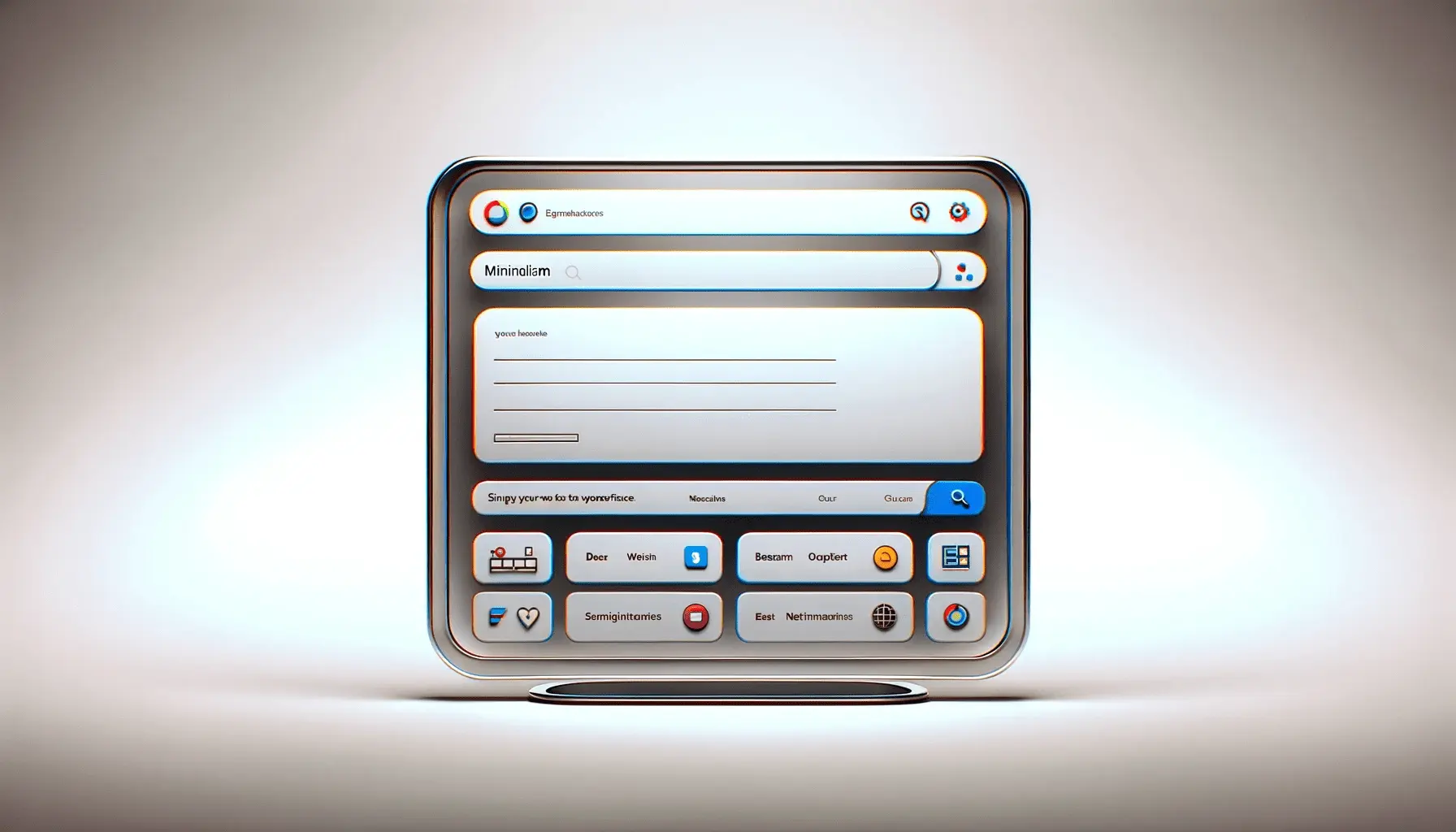In today’s digital age, where startups are burgeoning at an unprecedented rate, establishing a strong online presence is not just an option—it’s a necessity.
The cornerstone of this presence is undoubtedly the startup’s website, which serves as the face of the brand in the vast digital landscape.
However, creating a website that merely exists is not enough; it must be designed with the user at its core.
This is where the concept of User Experience (UX) in startup web design comes into play, transforming a simple website into a powerful tool for engagement, conversion, and customer retention.
The importance of UX in web design cannot be overstated, especially for startups striving to carve out their niche in competitive markets.
A well-designed UX offers a seamless, intuitive, and enjoyable interaction with the website, encouraging visitors to stay longer, explore deeper, and, ultimately, take the desired action—be it making a purchase, signing up for a newsletter, or downloading a white paper.
In essence, UX is the silent ambassador of your brand, communicating your values, ethos, and professionalism without saying a word.
- Understanding the Basics of UX Design
- The Role of User Research in UX Design
- Designing for Usability and Accessibility
- Visual Design and Its Impact on UX
- Responsive Design and Mobile Optimization
- Integrating Analytics and Feedback Loops
- Content Strategy and Its Influence on UX
- Empowering Startups Through Excellence in UX Design
- FAQs on User Experience in Startup Web Design
Understanding the Basics of UX Design
At its core, UX design is about understanding the user’s needs, preferences, and behaviors, and then creating an online experience that meets those needs as efficiently and enjoyably as possible.
It’s a multidisciplinary practice, blending elements of psychology, design, market research, and technology to create a cohesive and user-friendly interface.
For startups, investing in UX design from the outset is not just beneficial; it’s critical for survival and growth.
A startup’s website is often the first point of contact with potential customers, making it the perfect opportunity to make a lasting impression.
However, UX design is not a one-size-fits-all solution.
It requires a deep understanding of your target audience, including their online behavior patterns, preferences, and common pain points.
This understanding allows startups to tailor their web design in a way that not only attracts users but also keeps them engaged and satisfied.
Whether it’s the simplicity of navigation, the intuitiveness of the layout, or the responsiveness of the design across devices, every aspect of UX design plays a crucial role in shaping the user’s perception of the brand.
Key Components of Effective UX Design
- Usability: The website must be easy to use and navigate, allowing users to find what they’re looking for without frustration.
- Accessibility: Designing with accessibility in mind ensures that everyone, including users with disabilities, can have a positive experience on your site.
- Desirability: The design should evoke emotions and appreciation, making the user feel connected to your brand.
- Value: Your website should clearly communicate the value of your products or services, encouraging users to take the next step.
For startups, the challenge lies in balancing these components within the constraints of limited resources.
However, by prioritizing UX design and adopting a user-centric approach, startups can significantly enhance their chances of success in the digital arena.
It’s not just about making a website look good; it’s about making it work well for the user, thereby driving business goals and fostering brand loyalty.
Incorporating UX design principles into your startup’s web design strategy is not just an investment in your website; it’s an investment in your brand’s future.
The Role of User Research in UX Design
User research stands as the backbone of effective UX design, especially for startups aiming to make their mark.
It’s the process of gathering insights about your target audience’s behaviors, needs, motivations, and challenges.
This research is pivotal because it ensures that the design decisions you make are grounded in real user data, not just assumptions.
For startups, where every resource counts, understanding your user can mean the difference between a product that resonates and one that misses the mark.
Conducting user research might seem daunting, especially for startups with limited resources, but it doesn’t have to be.
Various methods, from surveys and interviews to usability testing and analytics, can provide valuable insights without breaking the bank.
The key is to start small and focused, gradually expanding your research as your resources allow.
This iterative approach to user research not only saves resources but also ensures that your UX design evolves in tandem with your growing understanding of your users.
Implementing User Feedback
One of the most direct ways to incorporate user research into your UX design process is through user feedback.
This can be gathered through beta testing, customer reviews, or direct outreach programs.
Feedback is a goldmine of insights, offering a firsthand look at what users love, what frustrates them, and what they wish for.
For startups, this feedback is invaluable, providing a roadmap for continuous improvement and innovation.
However, gathering feedback is just the first step.
The real challenge lies in analyzing this feedback, identifying patterns, and translating them into actionable design changes.
This requires a balance of quantitative data analysis and qualitative empathy to understand not just the what, but the why behind user behaviors and preferences.
By embracing user feedback as a cornerstone of your UX design process, startups can create products that truly resonate with their audience.
Creating User Personas
- Demographic Information: Age, gender, occupation, and location can provide a basic understanding of who your users are.
- Behaviors: How do they interact with your website or product? What are their browsing habits?
- Motivations: What drives them to seek out your product or service? What are their goals?
- Challenges: What obstacles do they face in achieving their goals, and how can your product help overcome them?
User personas are fictional characters created based on your research to represent the different user types that might use your site, brand, or product in a similar way.
Crafting detailed user personas can help startups visualize their target audience, making it easier to tailor design decisions to meet their specific needs.
Personas should be a key reference point throughout the UX design process, ensuring that every decision, from layout to content, is made with the user in mind.
Effective user research is not a one-time task but an ongoing process that should inform every stage of UX design, ensuring that the product remains aligned with user needs and expectations.
Designing for Usability and Accessibility
Usability and accessibility are foundational elements of UX design that ensure a website is functional and inclusive for all users.
For startups, focusing on these aspects from the beginning can significantly enhance user satisfaction and broaden their potential customer base.
Usability is about making your website easy and intuitive to use, minimizing frustration and maximizing efficiency.
Accessibility, on the other hand, ensures that your website can be used by people with a wide range of abilities, including those with disabilities.
Designing for usability involves a deep understanding of your users’ goals and creating a path that leads them to achieve these goals with ease.
This includes clear navigation, a consistent layout, and interactive elements that behave as expected.
Meanwhile, accessibility can be addressed by following established guidelines, such as the Web Content Accessibility Guidelines (WCAG), which provide a framework for making web content more accessible to people with disabilities.
By integrating these principles into the design process, startups can create more inclusive products that cater to a wider audience.
Optimizing Navigation and Interaction
Navigation is a critical component of usability, acting as the roadmap that guides users through your website.
A well-designed navigation structure should be intuitive, allowing users to find the information they need without confusion or delay.
This includes a logical hierarchy, clear labels, and a minimal number of clicks to reach desired content.
Similarly, interaction design focuses on how users engage with interface elements.
Buttons, links, and forms must be designed for ease of use, with clear feedback mechanisms to indicate their state and action.
For startups, simplifying navigation and optimizing interaction can drastically improve the overall user experience.
This might involve employing familiar design patterns, using consistent visual cues, and ensuring that interactive elements are easily recognizable and accessible.
These efforts can reduce user frustration, increase engagement, and encourage longer visit durations, directly impacting conversion rates and customer loyalty.
Implementing Accessibility Features
- Text Alternatives: Provide text alternatives for non-text content, such as images, to ensure that it can be accessed by screen readers.
- Keyboard Navigation: Ensure that all interactive elements are operable through keyboard-only navigation, catering to users who cannot use a mouse.
- Contrast Ratios: Maintain adequate contrast ratios for text and background colors to ensure readability for users with visual impairments.
- Scalable Design: Use responsive design techniques to ensure that your website is accessible and usable on devices of varying sizes and resolutions.
By prioritizing usability and accessibility, startups not only demonstrate their commitment to providing a positive experience for all users but also comply with legal standards and best practices.
This proactive approach can help mitigate the risk of alienating potential users and facing potential accessibility lawsuits.
More importantly, it reflects a brand ethos that values inclusivity and user-centric design, setting the foundation for long-term success in the digital marketplace.
Remember, usability and accessibility are not just technical requirements; they are ethical commitments to ensuring that your digital products are open and usable for everyone, regardless of ability.
Visual Design and Its Impact on UX
While usability and accessibility lay the groundwork for a positive user experience, the visual design brings this experience to life.
For startups, the visual aspect of their website is often the first impression potential customers will have of their brand.
It’s not just about aesthetics; visual design plays a crucial role in communication, brand perception, and user engagement.
A well-executed visual design can convey trustworthiness, professionalism, and brand identity, all of which are critical for startups trying to establish themselves in a competitive market.
Visual design encompasses the use of color, typography, imagery, and spacing to create a cohesive and appealing online presence.
Each of these elements must work in harmony to support the overall UX goals, enhancing usability rather than detracting from it.
For instance, color can be used to draw attention to key actions or areas, while typography must ensure readability across devices and screen sizes.
The challenge for startups is to balance creativity with clarity, ensuring that the visual design reinforces the user’s journey rather than confusing it.
Creating a Cohesive Brand Identity
A strong brand identity is essential for startups, and visual design is a powerful tool in building this identity.
Consistent use of logos, color schemes, and typography across all touchpoints can reinforce brand recognition and loyalty.
This consistency should extend to the website, social media profiles, marketing materials, and product design, creating a unified brand experience that resonates with users.
A cohesive brand identity not only helps startups stand out but also builds a sense of familiarity and trust with potential customers.
However, creating a cohesive brand identity goes beyond mere consistency.
It’s about telling a story that connects with your audience on an emotional level.
Visual design elements should reflect the brand’s values, target audience, and unique selling proposition.
For startups, this means diving deep into their brand’s personality and crafting visual designs that communicate this personality effectively.
Whether it’s through a minimalist approach that speaks to simplicity and efficiency or a vibrant and bold style that reflects creativity and innovation, the visual design should be a reflection of the brand’s core identity.
Enhancing User Engagement Through Visuals
- Imagery: Use high-quality, relevant images to create an emotional connection with users and illustrate your products or services effectively.
- Icons and Symbols: Employ icons and symbols to communicate complex ideas quickly and intuitively, reducing cognitive load and enhancing comprehension.
- Whitespace: Leverage whitespace (or negative space) to create a clean, uncluttered layout that focuses attention on the most important elements.
- Animations and Micro-interactions: Integrate subtle animations and micro-interactions to delight users, provide feedback, and encourage engagement.
For startups, investing in visual design is not a luxury but a necessity.
It’s a strategic tool that can significantly impact user engagement, conversion rates, and brand loyalty.
By carefully crafting the visual aspects of their website, startups can create an immersive and memorable experience that encourages users to explore, interact, and return.
The key is to align visual design choices with the overall UX strategy, ensuring that every visual element serves a purpose and enhances the user’s journey.
True visual design excellence lies in its ability to marry beauty with functionality, creating an environment where users not only enjoy their visit but are seamlessly guided towards achieving their goals.
Responsive Design and Mobile Optimization
In the era of smartphones and tablets, responsive design and mobile optimization have become non-negotiable elements of UX design for startups.
A responsive website automatically adjusts its layout, content, and interactions to fit the screen size and resolution of any device, ensuring a seamless and consistent user experience across desktops, tablets, and smartphones.
For startups, this adaptability is crucial, as it directly impacts user engagement, search engine ranking, and ultimately, conversion rates.
Mobile optimization goes beyond mere responsiveness.
It involves designing your website with mobile users specifically in mind, considering factors such as touch interactions, load times, and mobile-friendly navigation.
With the majority of internet traffic now coming from mobile devices, startups must prioritize mobile UX to meet their users where they are.
This means rethinking traditional design elements and interactions to ensure they are effective and enjoyable on a smaller screen.
Challenges and Strategies for Mobile UX
Designing for mobile presents unique challenges, from limited screen real estate to varying device capabilities.
Startups must navigate these challenges by adopting a mobile-first design philosophy.
This approach involves starting the design process with the mobile experience in mind and then scaling up to larger screens.
It encourages simplicity, focusing on core features and content that deliver value to mobile users without overwhelming them.
Strategies for effective mobile UX include simplifying navigation through hamburger menus or bottom navigation bars, optimizing images and media for faster loading times, and ensuring that buttons and interactive elements are sized for touch interactions.
Additionally, form design on mobile devices requires special consideration, minimizing the number of fields and leveraging device capabilities like GPS and cameras to streamline input.
Benefits of a Mobile-First Approach
- Improved User Satisfaction: A mobile-optimized website meets users’ expectations for speed, ease of use, and accessibility, leading to higher satisfaction and engagement.
- Increased Reach: By catering to mobile users, startups can tap into a larger audience, including those who primarily access the internet via mobile devices.
- Better SEO Performance: Search engines like Google prioritize mobile-friendly websites in their rankings, making mobile optimization a key factor in SEO strategies.
- Competitive Advantage: A superior mobile experience can set a startup apart from competitors, offering a key differentiator in crowded markets.
For startups, investing in responsive design and mobile optimization is not just about following trends; it’s about acknowledging the shift in user behavior towards mobile and adapting to meet these changes head-on.
By embracing a mobile-first approach, startups can ensure that their website is not only accessible but also engaging for the vast majority of users, regardless of the device they use.
This adaptability is a testament to a startup’s commitment to user experience, reflecting their understanding of the modern digital landscape.
Ignoring mobile optimization in today’s digital age is akin to turning away potential customers at the door. For startups, the mobile experience can no longer be an afterthought; it must be a cornerstone of UX design.
Integrating Analytics and Feedback Loops
For startups, the launch of a website is just the beginning of an ongoing process of optimization and refinement.
Integrating analytics and establishing feedback loops are critical for understanding how users interact with your site and identifying areas for improvement.
Analytics tools can provide a wealth of data on user behavior, from which pages are most visited to where users tend to drop off.
This data is invaluable for making informed decisions about UX design changes and enhancements.
Feedback loops, on the other hand, offer direct insights from users about their experiences and expectations.
This can come from various sources, including user surveys, feedback forms, and social media interactions.
By actively seeking out and listening to user feedback, startups can gain a deeper understanding of their audience’s needs and preferences.
This user-centric approach not only helps in fine-tuning the UX but also fosters a sense of community and loyalty among users.
Leveraging Analytics for UX Insights
Analytics can seem overwhelming at first, with a vast array of metrics and data points to consider.
However, focusing on key performance indicators (KPIs) related to UX, such as bounce rate, page load time, and conversion rate, can provide actionable insights.
For example, a high bounce rate on a specific page might indicate issues with content relevance or usability, prompting a closer examination and targeted improvements.
Heatmaps and session recordings are other powerful tools that can offer visual insights into user behavior.
Heatmaps show where users are clicking, scrolling, and spending time on a page, while session recordings provide a replay of user sessions.
These tools can uncover usability issues, such as confusing navigation or unnoticeable call-to-action buttons, that might not be apparent through traditional analytics alone.
Creating Effective Feedback Loops
Establishing effective feedback loops involves more than just collecting feedback; it requires analyzing this feedback and translating it into actionable improvements.
It’s important to categorize feedback based on its nature and potential impact, prioritizing changes that will enhance the user experience significantly.
Regularly updating users about the changes made in response to their feedback can also help in building trust and encouraging further engagement.
For startups, feedback loops should be an integral part of the product development cycle, with dedicated channels for collecting user insights.
This could include integrating feedback widgets directly into the website, conducting periodic user surveys, or even organizing user testing sessions for new features.
The key is to make feedback collection as easy and intuitive as possible for users, ensuring that their voices are heard and valued.
Analytics and feedback loops are not just tools for measuring success; they are essential mechanisms for continuous learning and improvement, driving the evolution of UX design in line with user needs and preferences.
Content Strategy and Its Influence on UX
Content is a pivotal component of UX design, serving as the medium through which a startup communicates its value proposition, engages users, and drives them towards conversion.
A well-crafted content strategy goes beyond mere text on a page; it encompasses the creation, delivery, and governance of useful, usable content.
For startups, developing a content strategy that aligns with user needs and business goals can significantly enhance the overall user experience, making content not just informative but also engaging and persuasive.
At the heart of a successful content strategy lies a deep understanding of the target audience.
This involves identifying user personas, understanding their information needs, and mapping out the user journey to determine how content can guide them towards their goals.
By tailoring content to meet user expectations at each stage of their journey, startups can ensure a cohesive and satisfying user experience that builds trust and encourages loyalty.
Key Elements of a Content Strategy
- User-Centric Content: Develop content that addresses the users’ questions, pain points, and interests, making it relevant and valuable to your audience.
- Clear and Concise Messaging: Use clear, jargon-free language that communicates your message effectively, enhancing readability and comprehension.
- Consistent Tone and Voice: Maintain a consistent tone and voice across all content to reinforce brand identity and build a connection with users.
- Visual and Multimedia Elements: Incorporate visual elements, such as images, videos, and infographics, to complement text and enhance user engagement.
- Search Engine Optimization (SEO): Optimize content for search engines to improve visibility and attract organic traffic, while ensuring it remains user-focused.
Implementing a content strategy requires coordination across teams, from marketing and design to development.
It’s a dynamic process that involves continuous testing, learning, and iteration to refine content based on user feedback and analytics.
For startups, this iterative approach to content strategy can be a powerful tool for driving growth, enabling them to adapt their messaging and content offerings to meet evolving user needs and market trends.
Measuring the Impact of Content on UX
To gauge the effectiveness of your content strategy, it’s essential to measure its impact on user experience and business outcomes.
This can involve tracking engagement metrics, such as time on page, bounce rate, and conversion rate, as well as conducting user surveys and feedback sessions to gather qualitative insights.
By analyzing this data, startups can identify which content resonates with their audience and why, enabling them to replicate successful strategies and adjust where necessary.
Ultimately, a content strategy should not be set in stone; it should evolve in response to user feedback, analytics, and changes in the business environment.
For startups, this means being agile and responsive, ready to pivot their content strategy to align with user expectations and market opportunities.
By placing content at the core of their UX design efforts, startups can create meaningful, engaging experiences that not only inform and delight users but also drive them towards meaningful actions.
Remember, content is more than words on a page; it’s a crucial element of the user experience, shaping perceptions, guiding interactions, and influencing decisions. A strategic approach to content can elevate the UX, turning visitors into loyal customers and advocates for your brand.
Empowering Startups Through Excellence in UX Design
The journey through the multifaceted world of User Experience in startup web design reveals a landscape where creativity meets functionality, driving startups towards achieving their ultimate goal: creating products and services that resonate deeply with their target audience.
In this digital era, where the competition is fierce and user expectations are higher than ever, UX design emerges not just as a design philosophy but as a strategic business tool that can significantly influence a startup’s trajectory.
The Pillars of UX Design for Startups
Throughout this exploration, several key themes have emerged, each playing a critical role in shaping the user experience.
From the foundational importance of user research to the intricacies of responsive design and mobile optimization, it’s clear that a successful UX strategy for startups is both comprehensive and nuanced.
The integration of analytics and feedback loops further underscores the dynamic nature of UX design, highlighting the need for startups to remain agile and responsive to user feedback.
Content as a Catalyst for User Engagement
Moreover, the strategic deployment of content within the UX framework illustrates its power not only to inform and guide users but also to engage and convert them.
A well-crafted content strategy, aligned with the principles of usability, accessibility, and visual design, can elevate the user experience, transforming passive visitors into active participants in the startup’s journey.
- User-Centric Design: At the heart of effective UX design lies a deep understanding of the user. Startups must prioritize user research and feedback to tailor their offerings to meet user needs and preferences.
- Accessibility and Inclusivity: Designing with accessibility in mind ensures that startups can reach a wider audience, fostering inclusivity and enhancing user satisfaction.
- Responsive and Mobile-First: In today’s mobile-dominated world, startups must embrace responsive design and mobile optimization to ensure a seamless user experience across all devices.
- Continuous Improvement: The integration of analytics and feedback mechanisms enables startups to continuously refine and improve their UX, staying aligned with user expectations and technological advancements.
- Content Strategy: Content is a powerful tool in the UX arsenal, capable of engaging users, conveying brand values, and driving conversions. A strategic approach to content can significantly impact the overall user experience.
In conclusion, the role of User Experience in startup web design cannot be overstated.
It’s a comprehensive approach that encompasses various disciplines, from visual design to content strategy, all aimed at creating a seamless, engaging, and memorable experience for the user.
For startups looking to carve out their niche in the digital landscape, investing in UX design is not just a wise decision—it’s an indispensable strategy for success.
By placing the user at the heart of their design process, startups can not only meet but exceed user expectations, fostering loyalty, driving growth, and setting the stage for long-term success.
Want your website to top Google search rankings? Leave the SEO to our professional agency!
FAQs on User Experience in Startup Web Design
Delving into the realm of User Experience in startup web design unveils a plethora of queries. Here, we address some of the most frequently asked questions to shed light on this crucial aspect of startup success.
UX (User Experience) focuses on the overall feel of the experience, while UI (User Interface) is about how the product’s surfaces look and function.
UX design is vital for startups as it directly influences user satisfaction, engagement, and conversion rates, ultimately impacting the startup’s success.
Startups can enhance their website’s UX by conducting user research, optimizing for mobile, simplifying navigation, and incorporating responsive design.
User research informs the design process by providing insights into user behaviors, needs, and preferences, ensuring the product meets user expectations.
Responsive design ensures a website’s layout and content look and function well on all devices, significantly improving the user experience.
Absolutely. Good UX design can lead to a more intuitive and enjoyable user experience, encouraging users to engage more deeply and convert.
Developing a UX strategy starts with understanding your target audience, defining user personas, and mapping out the user journey.
Startups should regularly review and update their UX design based on user feedback, analytics, and evolving best practices to stay competitive.











